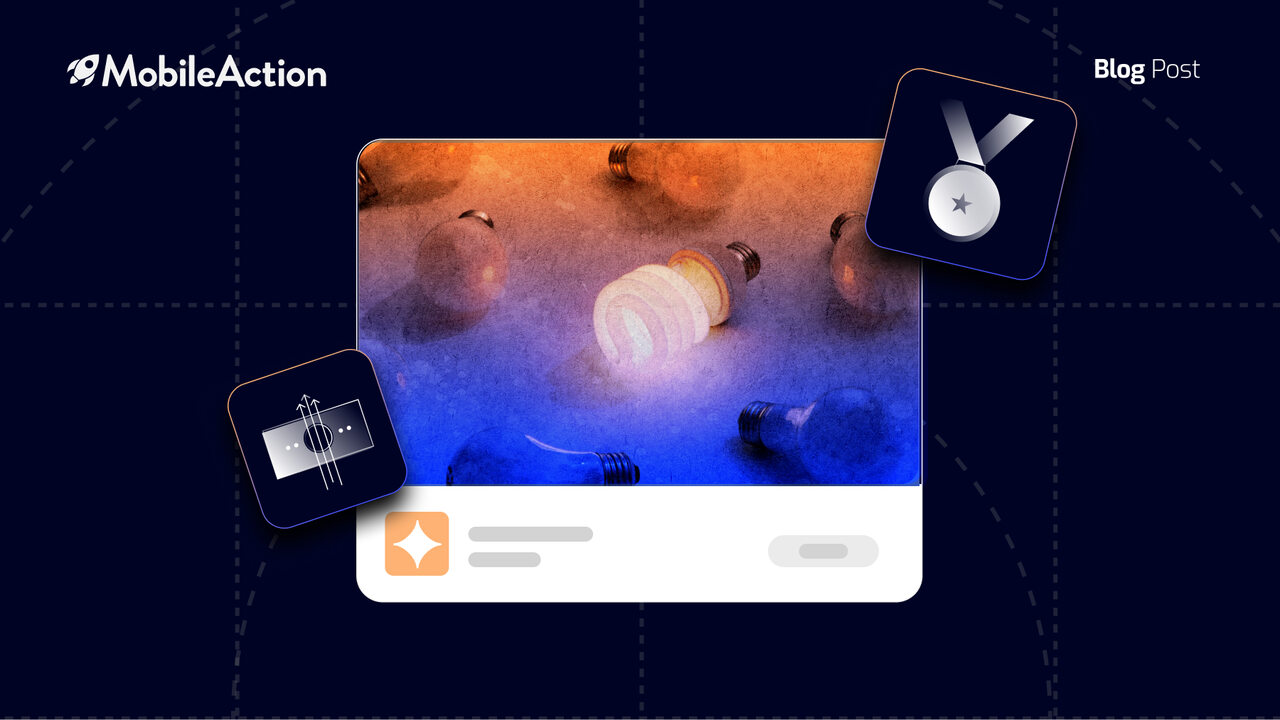Apple Search Ads is a powerful user acquisition channel. When used correctly, it can significantly increase your app growth and your revenue. You can check out our best practices post on Apple Search Ads if you would like an introduction to the platform. However, managing your budget effectively on Apple Search Ads can turn out to be more difficult than expected. As your goal is to increase profits, it is safe to assume that you will want to manage your money smartly. This post will provide you with some key points so you can manage your budget more effectively.
Understanding Auctions
The basic premise of Apple Search Ads is that if you win a bid on a keyword, your ad will appear at the top of the page. Slightly highlighted, Apple Search Ads has an average conversion rate of 50% which is very impressive. This makes the ad platform an incredibly powerful asset for mobile marketers.
Understanding how this system works can improve your performance. The first to mention is that Apple Search Ads uses a cost-per-tap system. You only pay if a user taps on your ad. Apple Search Ads allows you to set a maximum CPT so you do not overspend. However, the system works on a second-price-auction model. This means that you will pay $0.01 more compared to the second-highest bid. The amount you pay will not exceed your CPT.
It should be noted that paying more will not guarantee you will get the ad spot. Apple Search Ads does not want to harm the user experience. If users were to see irrelevant apps just because they paid more, this could potentially irritate them. That is why Apple Search Ads also takes into relevancy.
Your tap-through-rate is an important metric for calculating relevancy. If your ad has low TTR rates, Apple Search Ads will likely consider it irrelevant to the keyword bidding on. Thus it will become harder to win bids. On the other hand, if users are frequently tapping on your ad after seeing it, the platform will likely assume your ad is relevant and that will increase your chances of winning bids. If you would like to know more about increasing your chances of winning bids, you can read our post about Apple Search Ads auctions.
Utilizing Different Metrics
Generating revenue from a user is a rather long process. If you are using Apple Search Ads, the user starts interacting with your app the moment they see it on top of the page. Hopefully if they click on it, they will see your app listing page. Your product page may convince them to convert, resulting in an install. If your app is paid, you might get some revenue at this point. If not, you will have to wait for in-app activities to generate some income.
There are certain metrics associated with each one of these steps. By understanding your performance at each one of these stages, you can improve your app marketing strategy. Being aware of your weak points is the first step to improve them.
Apple Search Ads will track your campaign performance until the Install occurs. After the install, you also need the help of measurement partners to track in-app goals. By combining both sets of data, you will be able to reach maximum control over your performance. SearchAds.com can help you integrate this data without manual work needed, allowing you to spend more time on developing your strategy. Let’s take a look at some of those metrics.
- Cost-Per-Tap: This metric is provided by Apple Search Ads. It allows you to monitor how much money you spend on each tap on your ad. It can be considered as the top of the user-acquisition funnel.
- Tap-Through-Rate: The Tap-Through-Rate is crucial for your campaign’s efficiency. If your ads are underperforming on this aspect, optimization is necessary to increase your returns.
- Conversion Rate: The conversion rate reveals the percentage of people that download your app after seeing your ad. Deficiencies here can indicate problems in your product page.
- Cost Per Acquisition: This metric allows you to measure the amount of money you spend on each new install.
- Cost Per Install: Now that we are going down the funnel, metrics calculated by your MMP come into play. The cost-per-install rate allows you to see the amount of money you spent for each new user that opened your app.
- Cost Per Goal: As mentioned, some apps rely on in-app monetization to generate revenue. That is why metrics such as the CPI or CPA. For example, if the app monetizes with subscriptions, the CPI can show the amount spent on acquiring each new subscriber.
- Return-On-Ad-Spend: This metric can be considered the ultimate result of your advertisement campaign. How much money did you earn for each dollar you spent on advertising?
Optimizing Bids
Apple Search Ads displays only the app that won the bid for a keyword. Because the system operates by a cost-per-tap model, this allows users to avoid overspending. However, this also means that if you are failing on the bids, you might be never displayed on top of the page.
That is why you need to continuously optimize and adjust your bids according to their performance. For example, a keyword might be overperforming. It might have a CPI of $3 while the target CPI is $3.5. In such a case, you can increase your bids to increase your impressions along with your conversions. On the contrary, if a keyword is underperforming, you can lower your bid to improve your returns.
Or you might be bidding on a keyword that is relevant to your app, but it might be lacking impressions. This probably means that you are getting out-bid by competitors. Increasing your bid in this situation may help you to get more impressions and hopefully installs.
On the other hand, you might be spending considerable amounts of money on one keyword while it gets no conversions. This might call for a decrease in the bid to get your CPA lower.
Considering the number of keywords you might have in total, the amount of time needed to oversee them might get overwhelming. SearchAds.com allows you to automate this process, saving you both time and money with its Automation Tools. If you want to learn more, you can check out our post on the use of automation tools.
Utilizing Creative Sets
Not everyone is attracted by the same imagery. That is why your ad might be performing better for certain demographics while underperforming for others. This could also be the reason behind a low Tap-Through-Rate. People might not be clicking on your ad even though you have won the bid. Apple Search Ads created the perfect solution for this problem: Creative Sets.
Let’s assume that you have a multi-purpose app that allows people to trade, see real-time data from financial markets while also displaying news. You can match the features of your app with the keywords to display what the user needs. If the user searches for “trading,” you can use screenshots from your trading interface. On the other hand, if a user searches for “financial markets”, you can display your data interface.
Or you might have an app that sells clothes. With Creative Sets, you can display women’s products in your ad while doing the opposite for men. Of course, using Creative Sets only makes sense if it can outperform the default setting created by Apple. If you want to learn more about Creative Sets, check out our post on targeting your audience visually.
Scale Your Campaigns Now!
Apple Search Ads is a really effective ad network for promoting your product. As ads appear on the top of the page when a user searches for a keyword, the ad network is able to target already engaged users who are intending to download an app. This leads to high conversion rates and more efficient campaigns.
If you would like to find more efficient methods of utilizing your Apple Search Ads budget, schedule a free consulting session with our experts today!




